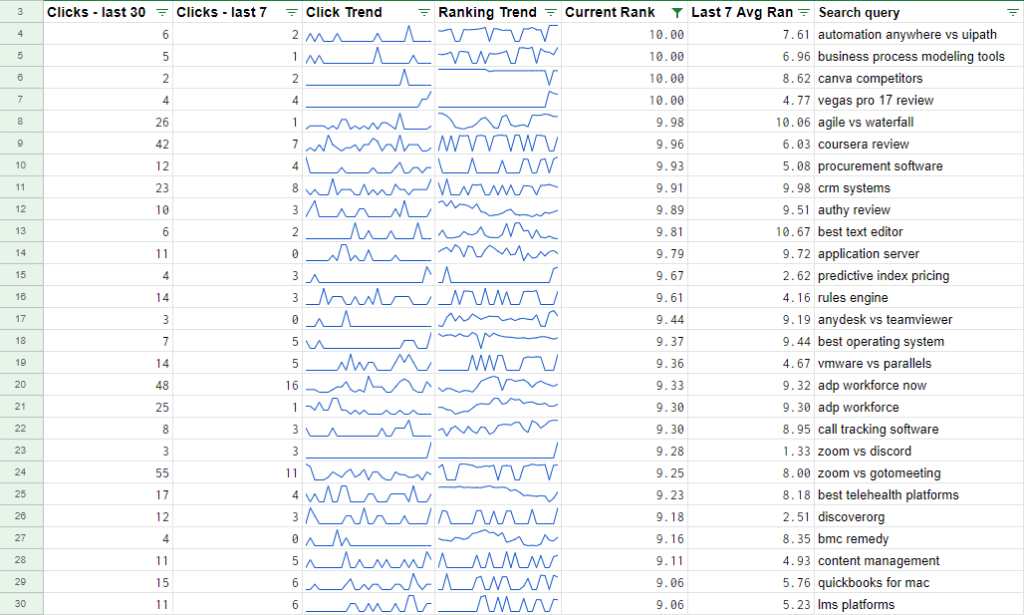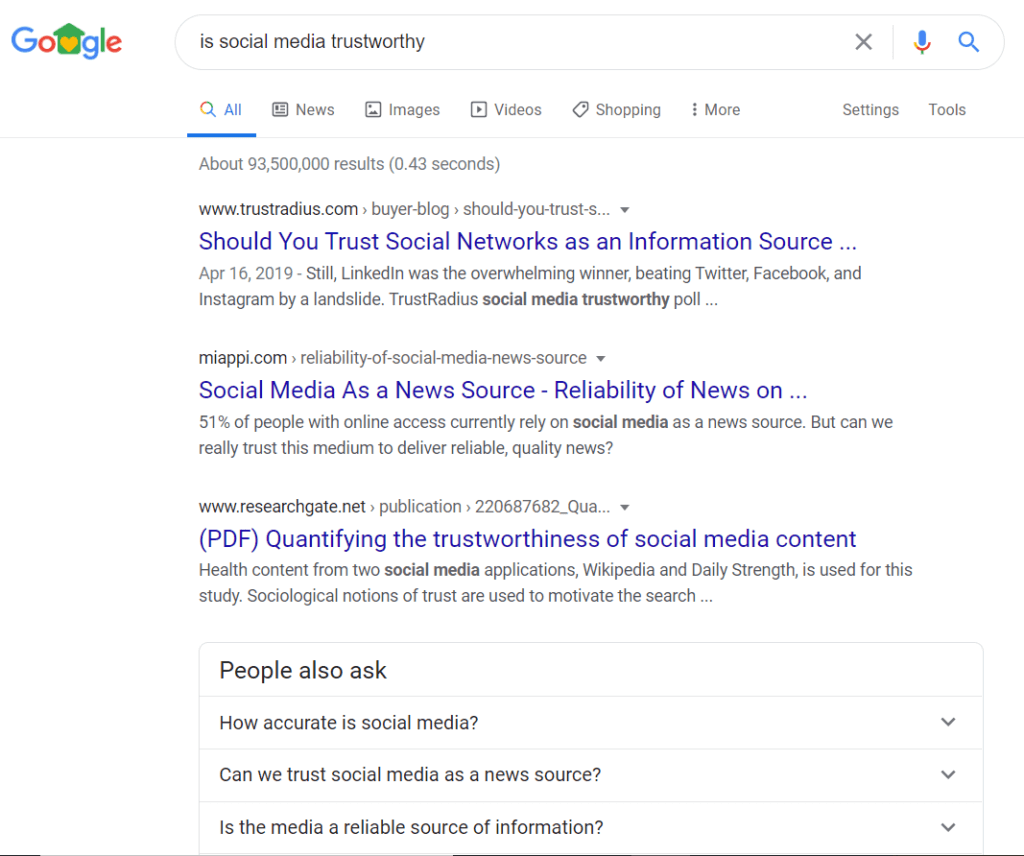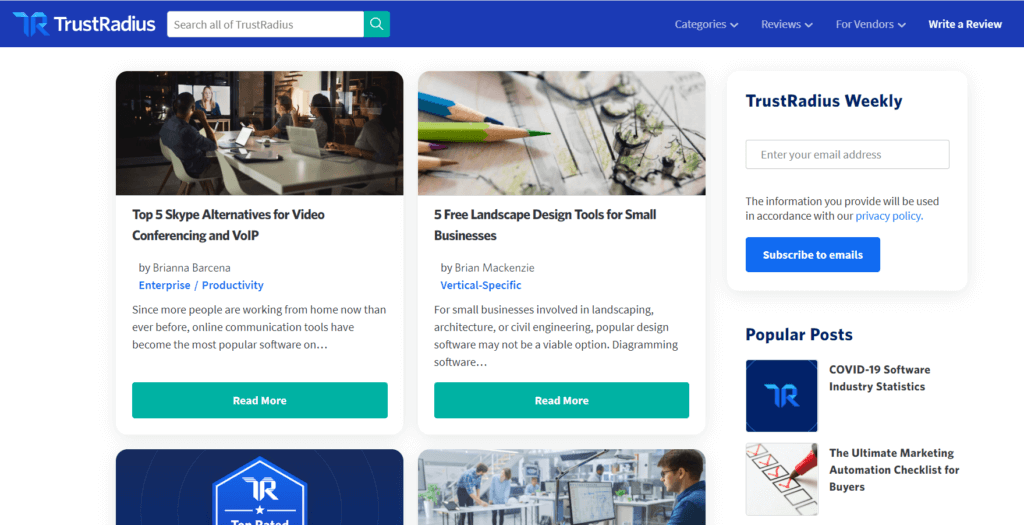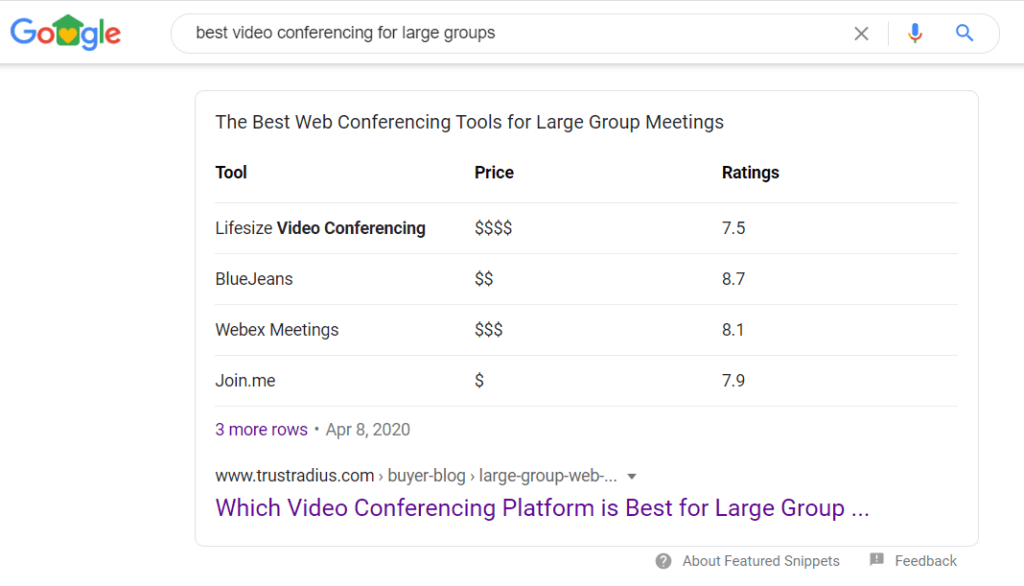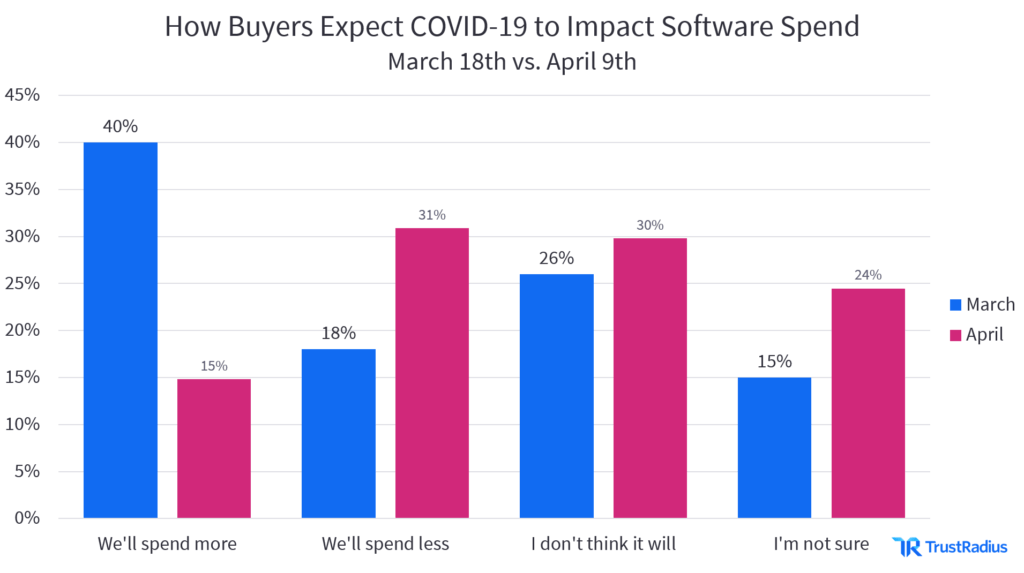The 7 SEO Best Practices We Use On The TrustRadius Blog
We recently implemented a new set of SEO best practices for the TrustRadius blog, and our goals were simple:
- Rapidly increase content quality across our site.
- Improve the SEO value of each new blog post we produce.
So far we’ve seen very positive results.
In the past six months, organic traffic to the TrustRadius platform has more than tripled, and we’re proud to announce that our site now sees over 1 million visitors per month. Blog traffic alone has grown 2X in that time period (as you can see in the sessions graph above). Since making that announcement, we’ve had countless requests to share how we made that success story happen.
The improvements we’ve made on our blog are just one tiny facet of the SEO machine we’ve built under the guidance of Mark Barrera, our Senior Director of SEO. But in the interest of transparency, we’d like to share those editorial insights with our community. Every drop in the bucket counts.
7 TrustRadius SEO Best Practices
1. Choose a high-value topic
2. Research your topic on page 1
3. Craft a clear and eye-catching title
4. Create a structured outline
5. Write thought leadership body text
6. Include images that add value
7. Upload with precision
The Guiding Philosophy Behind These Best Practices
By implementing these best practices, our goal was to produce the best content currently available for each of the topics we select. Google rewards sites that provide the best answer to a user’s query by ranking that content high on page 1. The better our content, the better chance we have of ranking and increasing TrustRadius traffic overall. Each of the best practices detailed below have been proven to increase rankings and contribute to a higher level of content excellence.
You can find a checklist version of this guide here:

1. Choose a High-Value Topic
The topics we write about on the TrustRadius blog are chosen by the SEO team through a high-level keyword research process before they are assigned to our Research Team for drafting. We select topics based on our team’s experience and our ability to rank for associated high-volume search terms. This strategy is crucial to our success in SERPs because Google now prefers webs of related content over a cherry-picked or “spray and pray” keyword strategy.
While we will not go into the details of our topic selection process here, stay tuned for a potential part 2 to this post that explores how we select the web of keywords surrounding each topic.
When starting on a blog post with a pre-approved topic, each TrustRadius writer does a gut check on the following strategy points:
WRITING
Our writers should feel confident in their ability to write on this topic based on their experience. OR, they feel confident in their ability to research, fill in the gaps, and write convincingly from the perspective of a subject matter expert. Our goal is to write on subjects we know well, so our content stands out in the marketplace as authoritative.
RANKING
Our writers confirm that we have a chance to rank for this topic based on the search volume and the competition seen on page 1 for relevant search terms. (See research section below for more details.) They also confirm that we do not already rank for these keywords, nor have we recently written a blog post on this topic.
PIVOTING
If our writers have questions or concerns about this topic, they are encouraged to raise a discussion with our team. This particular topic might not be a good fit for TrustRadius at this time, and flagging the issue will help us utilize resources elsewhere.
2. Research Your Topic on Page 1
Every good blog post starts with a Google search. We encourage our writers to google the primary keyword for this topic in an incognito window and see if the phrase autofills. This can be a good indication of search volume, and can present additional keyword variants for us to consider when drafting. From there, our writers make a thorough examination of the results on page 1. Their main objectives are:
- To blend in with those results to a certain degree.
- To stand out from those results by producing even more valuable content.
It’s also crucial that we glean search intent information for each topic based on what Google is serving on page 1. Google has more intent data than anyone, and they use that knowledge to showcase different types of content that serve that intent. This is why some search terms will show a preference for video / images / news / etc based on what users prefer. All of these nuances matter and impact the way we decide to frame and write our content.
Here are some specific things our writers look for when researching a topic:
Site types
Who are the big players on page 1 for this keyword? Are we seeing software vendors like Marketo and Salesforce? Publishers like PCMag and Forbes? Marketing blogs like Neil Patel or Hubspot? Other review sites? Taking note of site types will help you determine if your site can compete for a particular keyword. We also evaluate the Domain Authority/Rating of each site on page 1. If a handful of sites have DRs lower than our own, we have a better chance of ranking for that keyword.
Page types
What type of pages rank for this topic? And what type of page do we plan to produce?
- Some keywords (ex: marketing automation) pull up a full list of product pages from vendors looking to make a quick sale. TrustRadius could compete here with a category page, but probably not a blog post.
- Others (ex: marketing automation software) show results from B2B review sites like TrustRadius, with long comparison lists of 20+ products. Our category pages would compete here.
- Still others (ex: marketing automation and abm) show a handful of blog articles—which means Google is serving longform content to users who search this term. We could compete by publishing a blog post.
Title types
What patterns do we see among the titles on page 1? Are they all “how to” articles, numbered lists, or “vs” titles? If we see an overwhelming pattern, we’ll want to follow suit when crafting our own title. Our writers are tasked with the challenge of making our title stand out within that existing framework.
Date of publication
How old (or recent) are the pages on page 1? A list of outdated sources (pre-2017) indicates that we have the opportunity to add value by providing a more current perspective. Keep in mind that many sites will fake their publication dates by “updating” their content each year—so take all dates with a grain of salt.
Keyword usage
How many titles on page 1 use that specific keyword phrase in its entirety, exactly as it was typed in? If the entire SERP uses the keyword as written, we can infer that a huge number of people are writing on and searching for this topic. Competition is high. If titles are more keyword-adjacent (or even completely off base), it means we’ve found an opportunity to address the user’s intent better than what’s currently on page 1.
Word count
Our writers are encouraged to open all of the results on page 1 into new tabs and use this tool to find their average and median word count. We typically publish posts in the 1200-1800 word range, but this tool helps us narrow that range even further for each specific topic. Our writers determine the target word count for each topic and create posts that fit.
Content quality
With all of those tabs still open, our writers take time to actually read through all of the relevant listings on page 1. We recommend keeping a blank doc open while reading so you can take note of key ideas, useful external sources, and key terms/vocabulary that would be important to include in your post. Remember that the goal is to write the best content on page 1—a post that outranks each of these results by being more authoritative, more useful, or more engaging. While reading, the writer’s number one thought should be “how can I write something even better?” Between reading all of the results and following all the rabbit holes along the way, this research process should take between 1-2 hours per blog post.
3. Craft a Clear and Eye-Catching Title
In the “Research” section above, we discussed how to strategize a blog post title by examining the titles that already rank on page 1. Therefore, at this point, our writers should have an idea of what type of post makes sense to write for this topic. Now it’s time to craft a standout title that will catch the searcher’s attention.
Titles matter because click through rate is crucial for SEO success. This is a major way that Google judges quality, and pages with a higher CTR are likely to rank higher on page 1. Even without the ranking benefits, great titles help us convince people to click on our content first over other results with less enticing headlines.
Our writers create meta titles (which are the titles that show up in blue on a Google SERP) to be concise and fall within a 568 pixel guideline. In the past, we’ve published plenty of blog posts with titles that go over this recommended guideline. For example: post 1 at 719 pixels, post 2 at 948 pixels, and post 3 at 621 pixels. Now we encourage our writers to use this tool to ensure we stay under the 568 pixel mark and avoid truncation.
TrustRadius meta titles are designed to contain the most valuable keyword phrase within the first ~30 characters. That’s because B2B readers (and Google) tend to love simple titles that are brief and to-the-point. We avoid lengthy titles and titles with colons wherever possible. Our goal is to create titles that are keyword-focused, concise, and interesting enough to stand out on page 1 and win clicks over our competitors.
After that has been accomplished, we encourage our writers to be creative when they can. In many cases, we create a second, more creative article title for use on social media. That’s what we chose to do when workshopping the following example from our catalog:

Primary Keyword: Different types of HR Software
Old Meta Title: Management Software Turducken: What are the Different types of HR Software?
This title works well for social media, particularly if we publish around the holidays. However, as you can see in the screenshot above., the creativity of this title shifted the keyword phrase completely out of the SERP.
In this case, we would shorten and streamline the meta title so the primary keyword shows up at the very front of the SERP. The new meta title may be less creative, but it has a much better chance at ranking on page 1 and earning a higher click through rate. We saved the creative title for promotion on social media.
New Meta Title: What are the Different Types of HR Software?
4. Create a Structured Outline
TrustRadius blog posts are designed to be tightly structured, with clear sections and a skimmable outline that’s perfect for mobile users and busy B2B decision makers.
Each of our blog posts is organized with H2 sections and smaller H3 sections where necessary. Each section has a clear, concise, and interesting subheading. Our readers should be able to skim only the subheadings of a post and be led clearly from introduction to conclusion. We also make sure to include valuable and relevant keyword phrases in our subheadings that come from our initial topic/keyword research.
The overall structure of each post will change based on the type of content our writers choose to write (“how to” vs listicle vs analysis, etc). We’ve provided our writers with a list of possible options to help them quickly identify a potential structure to work with. For example:
- Product Comparison – We contrast the pros and cons of several software products
- Alternatives – We identify pain points and present product alternatives
- How to Buy – We provide tips/tricks on how to buy and implement new software
- How to Use – We offer tips/tricks on how to use specific software
- 101/Basic knowledge – We present entry-level info for category newcomers
- 201/Intermediate knowledge – We dive into specific advanced product features
- Industry trends – We present industry data, thought leadership, and forecasts
While each structure will have unique differences, a generic blog post outline could look like this:
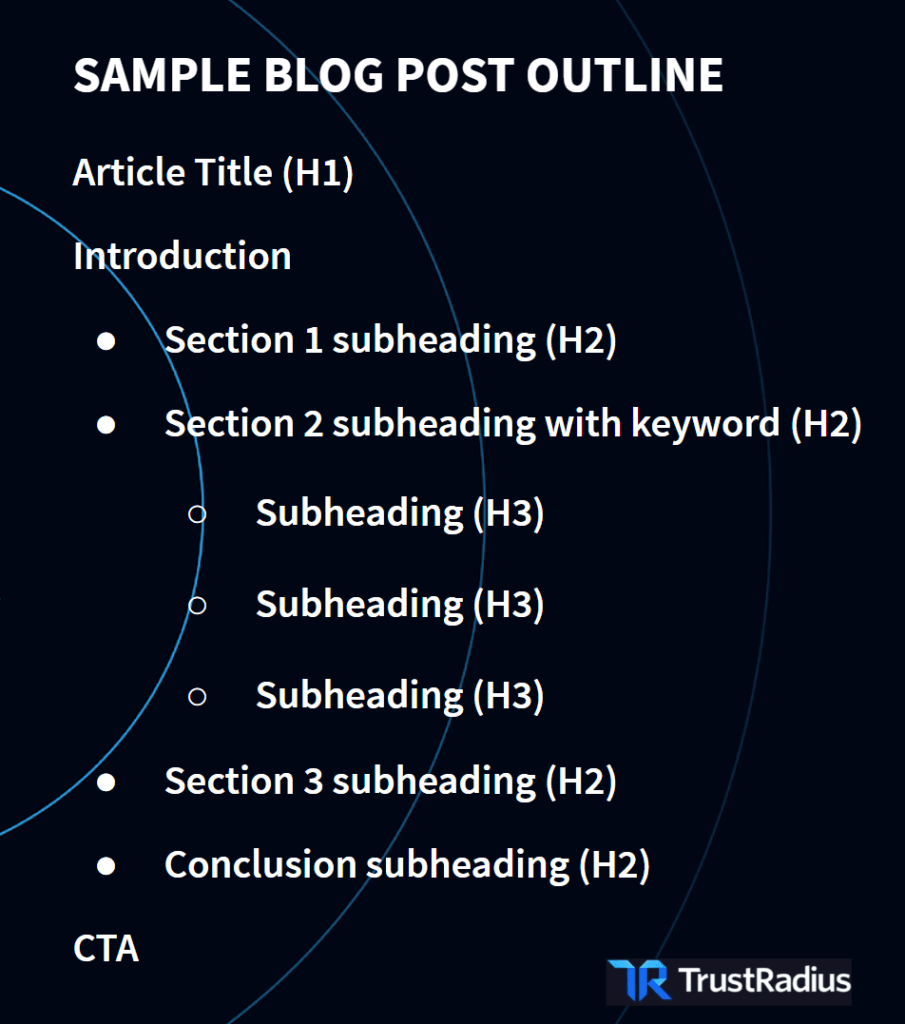
For comparison’s sake, here are a few examples of blog post structure:
- Great structure from other websites (post 1, post 2, post 3)
- Great structure from TrustRadius (post 1, post 2, post 3, post 4, post 5)
- TrustRadius blog posts that could use tighter structure (post 1, post 2)
NOTE: At this point we would ask our writers to submit a content brief for all of the steps above. Content briefs allow us to check progress before drafting begins, which saves our team a lot of time in revisions.
5. Write Thought Leadership Body Text
Now it’s time to actually sit down and write the post. Optimizing a page for Google is fairly easy. Writing content that people actually want to read is much harder. These copywriting best practices are designed to help our writers do both.
Introduction
The goal of the introduction is to captivate a reader from the very first sentence. We let readers know what to expect and entice them to read the rest of the post. Good introductions avoid cliches, colloquialisms, extraneous fluff, and general knowledge statements that our readers already know. Often, a good introduction will be excerpted as Google’s featured snippet for your primary keyword phrase.
We encourage our writers to try starting the introduction with the boldest statement they plan to make in the entire article. Or to begin the piece with a hard-hitting and highly relevant statistic. Or to hit on a pain point of our target audience. However they choose to do it, they need to create a “hook” that captures our readers’ attention from the very first sentence.
A note on salesy language: while we do mention TrustRadius in some post introductions, we are very careful to avoid writing anything too salesy. Casual mentions of our company, data, or expertise can lend credibility to our blog posts and entice our readers to follow our thought leadership. On the other hand, salesy language can make our posts feel pushy and forced and are likely to lead to higher bounce rates. Here’s a great example from our past catalog that uses the TrustRadius name to our advantage. This introduction bridges on salesy and could be softened for optimal effect.
For examples of good introductions, see the following: post 1, post 2, post 3
Links
Every blog post we publish for TrustRadius includes links to internal and external sources that are valuable to our readers.
We prefer for the first link in a post to go to an internal TR page—usually the primary category, comparison, or product page discussed in the post. Other internal links to blog posts and landing pages are strongly encouraged, and we try to include 3-5 internal links per post whenever possible. Going back to old articles in the same theme/subject, it’s really quite easy to find ways to internally link. For example, in this article we could mention and link to this article.
Many TrustRadius blog posts contain proprietary data that comes directly from surveys/polls by our Research Team. Every time we mention this data, we make sure to link to a resource where readers can find the full report.
While many B2B blogs shy away from third party sources, we don’t hesitate to link to external sources when they are high-quality and add value to our readers. Reliable primary sources (like research reports, studies, and market research) are always good to include when they are current (post-2017). We’ve found that adding third party sources to our own data posts helps add further credibility and authority to the arguments we present. We do avoid links to our direct competitors, but we are otherwise pleased to include high value third party sources.
Regardless of where the links come from, all TrustRadius blog post links are designed to feel natural, useful, and never salesy. Anchor text is always embedded in a sentence and contains no more than 3-5 words total. Phrases like Click here, Learn more, and More… are not acceptable as anchor text. The anchor text should clearly indicate what readers can expect to find when they click.
Looking through our blog post catalog, here are some good examples of valuable anchor text:
And some less good examples from the past:
^While this introduction is engaging, the link itself is missing the mark on a few points. The anchor text is too short. The linked resource is not relevant to the post and does not add value to our readers. And the website cited (Wikipedia) is not a reliable professional source.
^These links also suffer from the “too short” and “not valuable” afflictions. Our readers already know that Google is big and popular. There’s no reason to cite this information, because it doesn’t add any value to B2B decision makers.

^In contrast, this link is very useful to our audience but the anchor text is far too long. “50% of online consumers” would be better anchor text for this link. Alternatively, we could link to the phrases “environmental concerns” or “influence their purchasing decisions.”
Style
At TrustRadius, we endeavor to publish blog posts that are well-written with a natural, conversational, and professional style. Paragraphs should be short (3-4 sentences max) with only 3-4 paragraphs per H2 or H3 section. Sentences should be brief and to-the-point. We encourage our writers to utilize the Hemingway app to help achieve these metrics and streamline their writing style.
The ultimate goal is for our writing to be easily digestible by Google and our readers. Google is a bot that only has a certain level of language understanding. The more complex a sentence is, the more that context can be confused. Here are two resources we use when training our writers how to write specifically for NLP:
- “On-page SEO for NLP”: a useful overview from Briggsby
- “Better Content Through NLP”: a great whiteboard Friday from Moz
We also encourage our writers to include bulleted lists, tables, and charts to help break up complex information. These graphics could be coded directly into the HTML of the blog post (so they’re crawlable) or inserted as JPGs (so they’re shareable). The decision on whether to prioritize Google or social media is made on a case-by-case basis.
Here’s one example of a recent blog post where we chose to embed a crawlable table (rather than a jpg), and were rewarded with a featured snippet:
Our SEO team is currently working on producing a comprehensive brand voice and writing style guide for TrustRadius. This style guide will include more specific guidelines which can be applied to our blog content as well as cross-functionally across our company.
CTA
While our primary goal with the TrustRadius blog is to educate (not to drive demand), we do include CTAs within each blog post where they make sense. Usually these CTAs can be found at the end of each post, where we have a unique opportunity to lead readers to the logical next step. Offering a link to another helpful resource or a product comparison page often creates a really good UX for our audience.
Here are two solid CTAs from recent TR blog posts:
6. Include Images That Add Value
Every blog post we publish for TrustRadius features a relevant lead image that is at least 1200 px wide and adds value to our readers. We currently source lead images from TR branded content and credible stock image sites. We consider the following types of images valid:
- Text overlaid on TR-branded designs
- Screenshots of software or data
- Data / charts that include the TR logo
- Lifestyle imagery related to the content
- Memes and other funny images where relevant and according to fair use
- Embedded or screenshotted social content from Twitter/Instagram
These images must be high-quality and add value to the blog post. We’d prefer to use branded graphics whenever possible, because stock images often fall into the category of “not adding value.” We also like to include additional TR-branded charts / graphs / graphics beyond just the lead image to make our posts more visually dynamic. For example:
For SEO, each image must be accompanied by alt text—a brief summary sentence that describes the image and contains the primary keyword phrase. Alt text should be human friendly and unique for each image.
7. Upload With Precision
To upload in an SEO-approved way, our Research Team follows these final points:
- Check: We run entire blog posts through Grammarly and Copyscape to ensure there are no grammatical errors, typos, or citation issues.
- Format: We preview posts in WordPress to ensure that everything looks polished and professional. We adjust any spacing or formatting issues to improve skimmability.
- URL: We craft a URL that is concise and contains the primary keyword phrase, removing unnecessary prepositions and other small words. We do not include years in our URLs—this is one way we make our content evergreen.
- Links: We set all links to open in a new tab.
- Meta Description: We craft a compelling meta description according to these tips. The meta description is the paragraph that appears below the meta title in SERPs, and needs to include the primary keyword phrase and be interesting enough to inspire clicks. We try to keep our meta descriptions under 160 characters.
Implementing SEO Best Practices On Your Site
If you’ve gotten this far, you understand that these best practices are comprehensive and time consuming. Following each of these instructions makes a blog post take 4-5 times as long to produce. However, we believe in the ROI of that time investment. These best practices are a big part of what helped our blog traffic double in the past few months.
In truth, 1 high-quality piece of thought leadership that ranks for a valuable keyword is worth 100 mid-quality blog posts that aren’t optimized for SEO and don’t drive any traffic.
If you’re planning to implement a comprehensive set of SEO best practices for your own B2B blog, here are some tips from our recent experience:
- Train your writing staff thoroughly on these best practices before implementing them.
- Extend your publication timeline to allow for a rigorous review and revision process.
- Review your writers’ work at the “content brief” or outline stage to save time later on.
- Utilize the TrustRadius SEO Best Practices Checklist when reviewing each post.
- Don’t be afraid to prioritize quality over quantity.
As we continue to improve, TrustRadius is committed to sharing the insights that lead to our SEO success. To learn more about how we tripled our site-wide organic traffic in less than six months, check out this case study about our wildly successful title tag testing process.
You can also learn directly from Mark Barrera, Senior Director of SEO, in a free tell-all SEO webinar on May 13, 2020 at 12:00 CST. Reserve your spot or get the finished event for free on-demand here:







